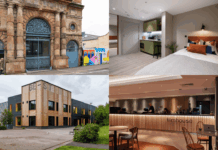
THE notorious ‘afternoon slump’ typically affecting office workers could soon be a thing of the past thanks to a group of researchers and a small Scottish firm.
Academics at Glasgow Caledonian University (GCU) and Cumbernauld-based Gas Sensing Solutions (GSS) are working on the project, which is being funded by CENSIS, the Innovation Centre for Sensors and Imaging Systems.
GCU and GSS have teamed up to create a smart building energy management system which can monitor air quality, predict a looming drop in atmospheric oxygen, and take action to improve it.
The system even knows how many people are in a room and adapts its behaviour to make the occupants more comfortable by adjusting air quality and temperature. GSS has provided the sensor, which can have a battery life of up to 10 years, and GCU researchers have invented a smart controller which reacts to, and learns from, its surroundings and responds accordingly.
The entire system is wireless, so a building with 20-30 rooms can have the devices fully fitted and operational in a matter of days.
Sensors are also fitted to the outside of the building to allow the system to react to external conditions.
Dr Hadi Larijani, GCU Senior Lecturer in the Department of Computer, Communications and Interactive Systems said the system would also help older buildings meet new environmental standards.
He said, “People have traditionally tackled afternoon drowsiness with making a cup of coffee, but in reality the issue tends to be associated with diminishing air quality.
“Modern building regulations have focused on thermal insulation, so insulating a building to prevent heat loss has the associated effect of preventing any fresh air getting in. That means the people inside are sitting in a room where the oxygen levels are falling throughout the day.
“Retrofitting air conditioning is expensive and doesn’t really address the central problem of air quality, whereas our system will make intelligent decisions about the conditions in the building and take action to address it.”
The technology being developed has a range of other applications, including real-time monitoring of heart patients in hospital.
Alan Henderson, Managing Director and co-founder of GSS, added, “This technology has huge potential – with a wide range of possible applications.
“Air quality is a ubiquitous challenge across the globe which presents us with a number of opportunities in different sectors and geographies.”
Mark Begbie, business development director at CENSIS, said the project highlights the huge potential of the Scottish sensors and imaging sector.
He explained, “The excitement, the interest, the challenge with SIS (sensors and imaging systems) is that there isn’t a facet of modern life which isn’t affected by sensors, whether it’s stability control in a car, CO2 monitoring in a classroom or jet engines sending data via satellite while in-flight.
“Feedback to the work we’re doing at CENSIS has been very positive.
“We have an industry-dominated board, by design. We have a number of key businesses represented on that board.
“The stakeholder model and approach to innovation support has been evolving for many years in Britain.
“One of the big effects of CO2 is that it makes you drowsy when concentrations get too high. CO2 monitoring is now mandated for new build schools.
“The amount of carbon dioxide in the air is a very good measure for how stuffy the room is.
“So you can develop demand-driven ventilation systems which give you a significant reduction in power consumption. You’re not simply achieving air changes for a worst-case scenario. You’re able to tune it for what the requirements actually are.
“The project is looking at embedding intelligence into sensors so that as part of the building management system, the CO2 sensor can provide higher value information. The sensors themselves can start to understand a bit about the behaviour of the building and give the system advice rather than just data.
“By driving the ventilation based on need, you can get significant reductions in operating costs.”
Sensor system technology is already hugely prevalent in everyday life – even if we don’t realise it.
Mark added, “I want to get a bottle of very expensive whisky and give that as a prize to the first person who can identify an area of life that isn’t impacted by sensor systems!
“Smartphones, for instance, will typically have GPS, three accelerometers, three gyroscopes and a 3 axis compass, so you’ve got ten sensors there and that’s without even thinking about microphones.
“I think we’re going to see more intelligence being built into buildings – domestic and commercial.”











